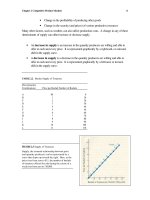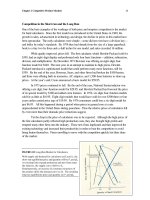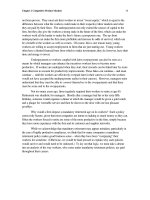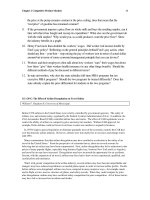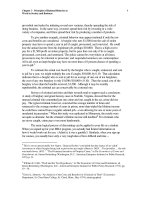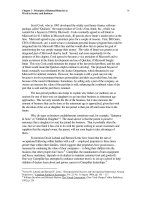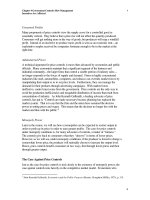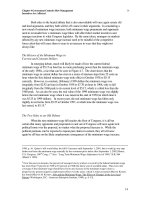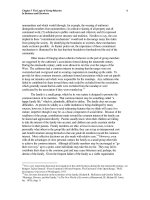Tài liệu Microeconomics for MBAs 11 ppt
Bạn đang xem bản rút gọn của tài liệu. Xem và tải ngay bản đầy đủ của tài liệu tại đây (125.98 KB, 10 trang )
Chapter 3 Principles of Rational Behavior at
Work in Society and Business
18
Scott Cook, who in 1983 developed the widely used home-finance software
package called “Quicken,” the major product of Cook’s firm, Intuit, Inc., which was
courted for a buyout in 1994 by Microsoft. Cook eventually agreed to sell Intuit to
Microsoft for $1.5 billion in Microsoft stock, 40 percent above Intuit’s market price at the
time. Microsoft agreed to pay a premium price for a couple of reasons. First, Bill Gates,
CEO of Microsoft, saw a need to have a dominant personal finance program that could be
integrated into his Microsoft Office line and that would allow him to pursue his goal of
transforming the way people manage their money. The value of Intuit was greater as an
integrated part of Microsoft than by itself. Second, and more importantly for the
purposes of this chapter, Cook agreed to become a vice president of Microsoft and to
retain an interest in the future development and use of Quicken, if Microsoft bought
Intuit. This way Cook could minimize the impact of the last-period problem, and the sale
of Intuit would mean that Quicken might continue to develop. The proposed buyout of
Intuit eventually was terminated by the Justice Department, which threatened to sue
Microsoft for antitrust violation. However, the example is still a good one not only
because it involves prominent business personalities and their successful firms, but also
because of the moral it illuminates: Sometimes, by selling only a part of the company, an
owner can increase the value of the part that is sold, enhancing the combined value of the
part that is sold and the part that is retained.
The last-period problem also helps to explain why fathers (or mothers) are so
anxious for one of their sons (or daughters) to go into their business as retirement age
approaches. This not only extends the life of the business, but it also increases the
amount of business that can be done as the retirement age is approached, given that with
the elevation of the son or daughter, the last period is then put off until some time in the
future.
Why do signs on business establishments sometimes read, for example, “Sampson
& Sons” or “Delilah & Daughter”? The usual answer is that the parent is proud to
announce that a daughter (or son) has joined the business. That is probably often the
case, but we also think it has a lot to do with the parent seeking to assure customers and
suppliers that the original owner, the parent, will not soon begin to take advantage of
them.
Economists David Laband and Bernard Lentz have found that the rate of
occupational following within families with a self -- employed proprietor is three times
greater than within other families, which suggests that proprietors have good reason --
measured in continuing the value of their companies -- to bring their children into the
business that other people don’t have.
8
Caterpillar, the manufacturer of farm equipment
and heavy machinery, depends on its dealers to maintain customer trust and goodwill.
One way Caterpillar has attempted to enhance customer trust is to set up a school to help
children of dealers learn about and pursue careers in Caterpillar dealerships.
9
8
David N. Laband and Bernard F. Lentz, “Entrepreneurial Success and Occupational Inheritance Among
Proprietors,” Canadian Journal of Economics, Vol. 23, No. 3 (August 1990), pp. 101 -- 117.
9
William Davidow and Michael Malone, The Virtual Corporation, (New York: Harper Collins Publishers,
1992), p. 234.
Chapter 3 Principles of Rational Behavior at
Work in Society and Business
19
Firms commonly complain that goods delivered in the last days of the supplier’s
operation are of inferior quality. The problem? It may be one of the incentives, or lack
thereof, that people have to deliver goods of waning quality during their last days.
Bankruptcy laws can be explained in part as a means of reducing these end -- period
problems.
10
They extend the potential end of the firm, and can give the firm a new lease
on life and set back the last-period problem indefinitely.
Also, a firm in financial trouble can be pressed into liquidation by nervous
bondholders, a fact that can exacerbate the last-period problem, given that suppliers
would have to worry that nervous bondholders will encourage firms to deliver shoddy
merchandise, which can make customers more nervous about dealing with the financially
strapped firm. By allowing firms in financial trouble to continue operating, bankruptcy
laws make it more likely that the bankrupt firms will keep up the quality of the products,
and provide more motivation for suppliers to keep up honest dealing.
The Keiretsu As a Solution to the Last-period Problem
Japanese firms are renown for organizing themselves into groups of firms called
keiretsus. Keiretsu members buy from one another, share information, and organize
joint ventures to produce goods and services in concert with one another. The largest and
best-known keiretsu is Mitsubishi, which has 28 core member firms and hundreds of
other firms that are loosely tied to the core firms. They integrate their activities in a
number of ways, not the least of which is having their headquarters close together, having
the CEOs of the various firms meet regularly to exchange information, and organizing
social and business clubs that are open to employees of the keiretsu member firms. The
members often own stock in one another.
In the United States, many of the activities of any keiretsu would likely worry the
antitrust authorities because the organization would be construed as monopolistic. No
doubt, some keiretsu activities might indeed restrain competition in some markets,
causing prices of Japanese goods to be higher than they otherwise would be (especially in
the domestic market where competition from other producers from around the world
might be impaired by import restrictions). The keiretsu might also be seen as a highly
efficient means by which Japanese firms are able to make use of new technologies,
quickly incorporating them into products. The Japanese have demonstrated a knack for
bringing new products to market quickly.
However, we mention the keiretsu organizational form here only because of one
of its more unheralded benefits: it is a form of business organization that seeks to solve
the last-period problem. The integration of the member firms’ purchases and sales and
strategic plans for the future is a means by which members can assure one another that
their business relationship will be enduring -- or that the member employees have
minimum incentive to behave opportunistically in the short -- run and have maximum
10
Gibbons and Murphy, “Optimal Incentive Contracts in the Presence of Career Concerns.”
Chapter 3 Principles of Rational Behavior at
Work in Society and Business
20
incentive to work with their joint future income stream in mind.
11
Being ousted from the
keiretsu can inflict substantial costs on the opportunistic firms and their employees. Even
the social gatherings of keiretsu employees can be construed as a means by which the
employees can “bond.” Here, we are not so much concerned with the “warm and fuzzy”
feelings people might have from integrating their lives. Instead, we mean that by
integrating their lives at the social level, employees can provide each other mutual
assurance that they will live up to expectations in their business dealings, that they will
not act opportunistically. The employees can lose the long -- term benefits of their social
and business relationships.
12
In short, the keiretsu is a clever means by which opportunistic behavior is made
more costly. It seeks to reduce some of the shirking and monitoring costs of doing
business, when business is done at arm’s length.
Indeed, one of the more unrecognized benefits of the firm in general is that it
does, under one “roof,” what is attempted under a keiretsu. The firm seeks to bring
people together and have them associate and work together on a continuing basis for the
purpose of minimizing the last-period problem. As we noted early in the book, it’s quite
possible for all departments within a firm and all stages of an assembly line to be
operated on a market basis, with every department and every stage of the assembly line
buying from one another. However, you can imagine that such an organization of
economic activity would give rise to a multitude of last-period problems, especially if
there were no attempt to ensure that everyone “worked together” as something
approximating a keiretsu.
The Japanese relatively greater use of formal and informal long -- term buyer --
supplier relationships – sometimes cited as “strategic industrial sourcing” combined with
so -- called “relational contracting” -- may be partially explained by the fact that the
Japanese, as commonly argued, have the required business culture, one grounded in a
long -- term, future -- oriented business perspective that prescribes long -- term contracts.
The Japanese may, to a greater degree than Americans and Europeans, have a pervasive
sense of duty that insures that the parties will abide by any contracts that have been
consummated, and the Japanese may have a greater aversion than others to ongoing
contentious bargaining relationships that would be required if contracts were always up
for grab by the low -- cost bidders.
13
The long -- term business relationships may also be
a consequence of the growing affluence in Japan, which has elevated the importance of
quality over price that, in turn, has induced large Japanese firms to work with their
suppliers in an effort to enhance product quality.
14
The long -- term contracting can also
be explained partially by the encouragement the Japanese government gave to the
11
For an interesting discussion of the keiretsu, see Clyde V. Prestowitz, Jr., Trading Places: How We
Allowed Japan to Take the Lead (New York: Basic Books, Inc., 1988), pp. 156 -- 166.
12
As Clyde Prestowitz notes, “Thus the Keiretsu system reduces risks for the Nippon Electric Company
and the other Japanese companies through the accumulation of relationships that can be counted upon to
cushion shock in time and trouble” (ibid., p. 164).
13
This explanation for long -- term contracting has been argued at length by Ronald P. Dore, Taking Japan
Seriously (Stanford, Calif.: Stanford University Press, 1987).
14
Ibid., p. 188.
Chapter 3 Principles of Rational Behavior at
Work in Society and Business
21
creation of long -- term buyer -- supplier relationships in the past (especially during
World War II) and the existing laws and legal sanctions against abusive treatment of
subcontractors by their customers.
15
But it seems to us altogether reasonable that long -- term contracting must be
grounded in factors other than culture and affluence. One economic explanation may
start with a recognition of the extent to which firms are integrated in Japan. The fact of
the matter is that in some industries Japanese production is far less integrated into
identified “firms” than, say, in the United States and other countries. In the United States
and Western Europe, for example, 50 to 60 percent of the automobile manufacturing
costs are incurred “in -- house.” In Japanese firms, on the other hand, only 25 to 30
percent of the automobile production costs are typically incurred “in -- house,” or inside
Japanese firms.
16
Only 20 percent of Honda’s production costs are incurred inside, which
means it buys 80 percent, or $6 billion, of its inputs from outside suppliers.
17
Because of
the lack of integration, Japanese firms may need to develop long -- term buyer -- supplier
relationships to a much greater degree than more highly integrated firms do just to
overcome the potential last-period problems, if nothing else.
Put another way, Japanese firms are able to engage in what is called strategic
outsourcing, and do so competitively, because they are willing and able to develop long -
- term working relationships. If they didn’t, they would have to endure the added costs
associated with the ever -- present closing of those relationships. It doesn’t surprise us
that many buyer -- supplier relationships in Japan give the “look and feel” of integrated
firms with buyers and suppliers helping each other and investing in each other (which is
what happens, to more or less degree, within unified firms).
When Honda signs a contract with a supplier, it expects the working relationship
to continue for 25 to 50 years, which effectively means that the last-period problem is set
back considerably.
18
Moreover, the permanence of the buyer -- supplier relationship is
two -- way, with commitments on the parts of both buyers and suppliers. Buyers agree to
stay with the suppliers, and vice versa, through ups and downs (at least up to a point).
Hence, Honda can justify incurring the costs associated with helping its suppliers
increase productivity, even provide the needed technology and specialized equipment.
Moreover, such expenditures, plus investments in the specific assets of the suppliers, by
Honda have the added advantage of being a bond, the value of which is forgone if Honda
does not abide by its agreement. Managers at Honda are basically saying to suppliers,
“Look at what we are doing. We are serious in our commitment. If we renege, our up --
front investment will be worth very little. We will lose our projected income stream from
the investment. Because of those costs, you can count us in for the long run.” Such tie --
ins aid in making the contracts self -- enforcing and durable; they help to make the long
run a viable perspective.
15
Ibid.
16
As reported in Toshihiro Nishiguchi and Masayoshi Ikeda, “Suppliers’ Process Innovation: Understated
Aspects of Japanese Industrial Sourcing,” in Managing Product Development, edited by Toshihiro
Nishiguchi (New York: Oxford University Press, 1996), pp. 206 -- 230.
17
As reported in Lisa H. Harrington, “Buying Better,” Industry Week, July 21, 1997, pp. 74 -- 80.
18
Ibid.
Chapter 3 Principles of Rational Behavior at
Work in Society and Business
22
The Role of Markets
Should production be rigidly integrated as in American firms or more loosely integrated
as in Japanese business consortiums? We surely cannot answer that question with the
certitude that many readers will want. Japanese firms obviously gain the benefits of
keeping their suppliers in a position that is marginally more tenuous and, maybe, more
competitive with other potential suppliers, but they have to deal with the marginally more
severe last-period problems. Many factors, which are offsetting and subject to change
with the costs associated with contracting and with principal/agency problems we have
discussed, are involved. We suspect that different organizational forms will suit different
situations and eras (as has obviously been the case in Japan where relational contracting
has not always been prevalent
19
).
Answers will come from real -- world experimentation in the marketplace. We
suspect that competition will press firms to adjust their organization forms, and the
inherent incentive structures, as some variation of organizational form is relatively more
successful. Many American firms have had to seriously consider and, to a degree,
duplicate the added organizational flexibility of Japanese firms. Why? Their
management methods have obviously worked in some industries, most notably the
automobile industry. It takes 17 hours to assemble a car in Japan and 25 to 37 hours to
assemble a comparable car in the United States and Europe. Japanese firms can develop
a new car in 43 months, whereas it takes American and European firms over 60 months,
and Japanese cars come off the production lines with 30 percent fewer defects. The worst
American -- made air conditioning units have a thousand defects for every defect in the
best Japanese -- made units.
20
Firm integration and relational contracting are hardly the only means of
moderating last-period problems. Joint ventures, which more often than not require up --
front investments by the firms involved, can also be seen as extensions of firm efforts to
reduce last-period problems, with the potential of enhancing the quality of the goods and
services produced and lowering production costs. Joint ventures might lower production
costs because they give rise to economies of scale and scope through the application of
technology, but they also can lower production costs by lowering the potential costs
associated with opportunistic behavior and monitoring. They make the future income
streams of each party a function of the continuation of the relationship.
* * * * *
The “last-period” problem is nothing more than what we have tagged it, a
“problem” that businesses must consider and handle. It implies costs. At the same time,
firms can make money by coming up with creative ways of making customers and
suppliers believe that the “last period” is some reasonable distance into the future.
Failing firms have a tough time doing that, which is one explanation why the pace of
19
See Toshihiro Nishiguchi, Strategic Industrial Sourcing: The Japanese Advantage (New York: Oxford
University Press, 1994), chap. 2.
20
As reported with citations to other sources by Nishiguchi, Strategic Industrial Sourcing, pp. 5 -- 6.
